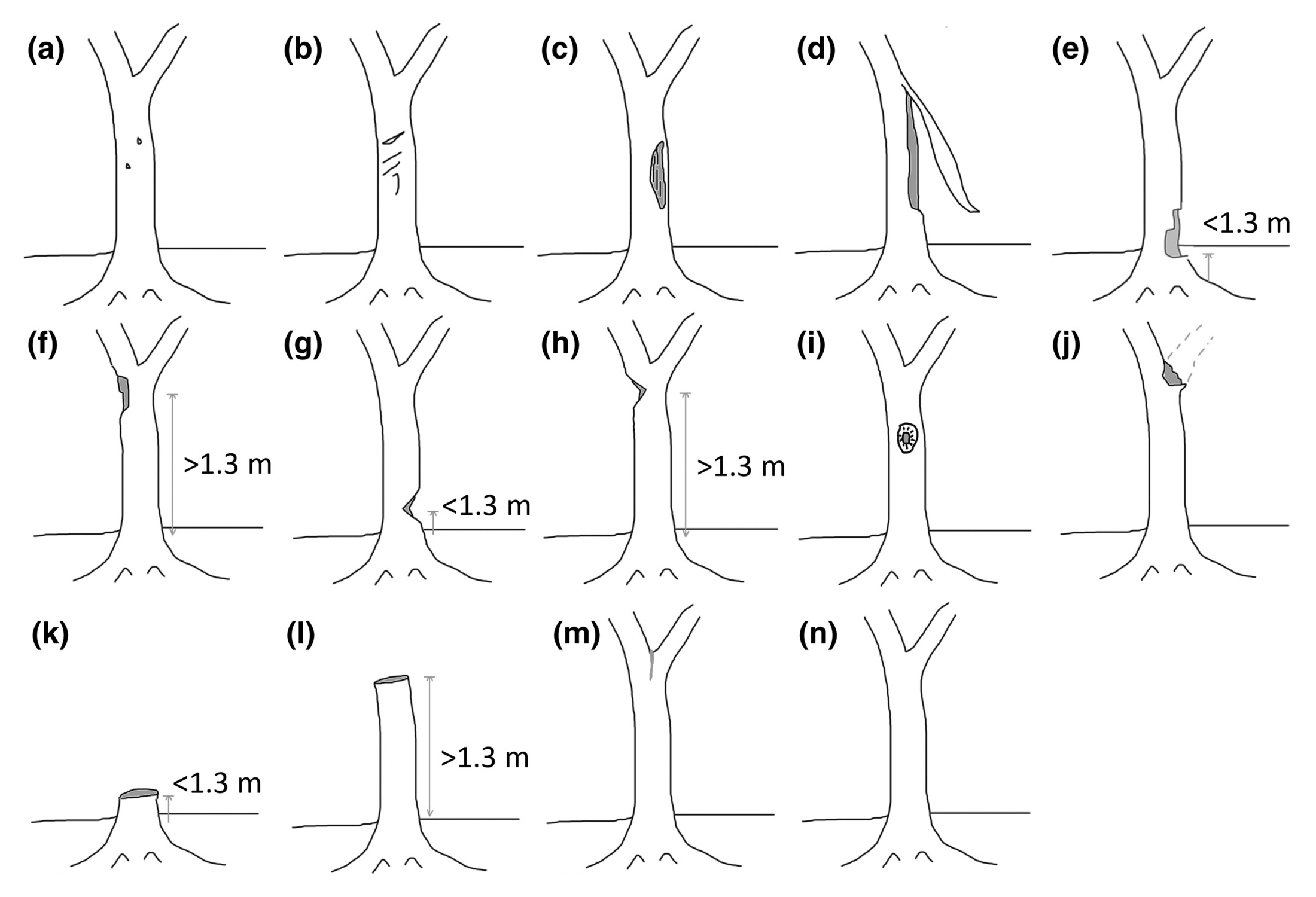

Family: Thymelaeaceae (瑞香科)
Scientific name: Aquilaria sinensis (Loureiro) Sprengel
Chinese name:
土沉香
Wound type: g. Angle sawed below breast height (胸下斜鋸)
Loading...
Thymelaeaceae (瑞香科) | Angle sawed below breast height (胸下斜鋸)
of Aquilaria sinensis (Loureiro) Sprengel (
土沉香 -
樹幹及傷口
)
by H. L. Wang 1, 2, 3 T. H. Wong 4
- Photographer
- Mesh-reconstructor
- Mesh Editor
- Mesh Label
 Rotate model
Rotate model
 Zoom in/out
Zoom in/out
 Move model
Move model
 Rotate model
Rotate model
 Zoom in
Zoom in
 Zoom out
Zoom out
 Move model
Move model
Wound classification system of A. sinensis

- Drilled-hole patches (鑽孔): Small circular hole patches were induced on the tree trunk. The hole diameter was <50 mm. This type of wound was induced during agarwood formation. Wound induction methods included drilling, burning-chisel drilling, and injection of agarwood inducers or fungi (Azren et al., 2019; Chowdhury et al., 2016; Talucder et al., 2016).
- Slash patches (割痕): Long scars with <20 mm depth were induced on the tree bark. This type of wound was induced during agarwood formation. Methods of wound induction included axing, knife chopping, and partial trunk pruning (Chowdhury et al., 2016; Talucder et al., 2016).
- Peeled bark (剝皮): The tree bark was removed, and the cambium layer was exposed. This type of wound was induced during agarwood formation. Wound induction involved bark peeling (Akter et al., 2013; Chowdhury et al., 2016).
- Vertical cleaving (縱向分裂): Part of the trunk was cleft and tilted at an angle from the remaining part of the trunk. The tree remained alive in this situation. This type of wound was induced during agarwood formation. The method of wound induction involved cleaving the trunk vertically using an axis or chopper, and obstacles, such as stones, which might be placed at the cleaving point to tilt the trunk.
- Horizontal sawed below breast height (胸下橫鋸): Part of the trunk was removed with the horizontal cutting edge and the wound was located at <1.3 m from the ground. This type of wound was used for agarwood formation and collection.
- Horizontal sawed above breast height (胸高橫鋸): Similar to the characteristics described in “(e) Horizontal sawed below breast height,” but the wound was located at >1.3 m from the ground.
- Angle sawed below breast height (胸下斜鋸): Part of the trunk was removed with an angled cutting edge and the wound was located at <1.3 m from the ground. This type of wound was used for agarwood formation and collection.
- Angle sawed above breast height (胸高斜鋸): Similar to the characteristics described in “(g) Angle sawed below breast height,” but the wound was located at >1.3 m from the ground.
- Chiseled (鑿孔): An irregularly-shaped hole was found on the trunk. The chiseled holes recorded in this study were usually found above breast height. The diameter of the hole was >50 mm. This wound type was induced for agarwood formation and collection by using the hole digging method.
- Side branch removal (分枝鋸斷): The side branch of the tree was completely chopped. This type of wound was induced for agarwood collection using a sawing method.
- Trunk removal below breast height (胸下鋸斷): The tree trunk was felled so that only the stump remained. The removed trunk was further exploited by poachers to find the agarwood embedded inside. The cut was located <1.3 m from the ground. This type of wound was induced for agarwood collection using a sawing method.
- Trunk removal above breast height (胸高鋸斷): Similar to the characteristics described in “(k) Trunk removal below breast height,” but the cut was found at >1.3 m from the ground.
- Natural wound between branches (枝間自然裂傷): Wounds were induced naturally between two diverging branches.
- A non-damage trunk (無損傷): No wound, intact trunk and branches
Publication:
Ho Lam Wang, Tin Hang Wong, Ka Yip Eric Liu, Ho Leung Ryan Tsang, David Tai Wai Lau (2024). 3D documentation and classification of incense tree Aquilaria sinensis (Lour.) Spreng. wounds by photogrammetry and its potential conservation applications, http://dx.doi.org/10.1002/ece3.11536
Acknowledgement 鳴謝:
Wu Jieh Yee Charitable Foundation Native Plant Resources and Database in Hong Kong
伍絜宜慈善基金香港原生植物資源及教材庫

